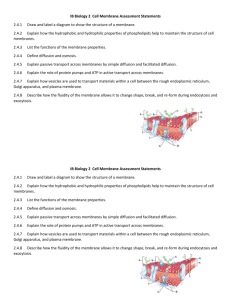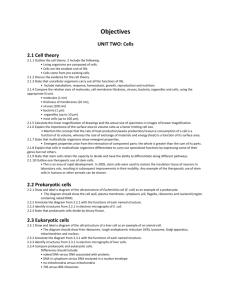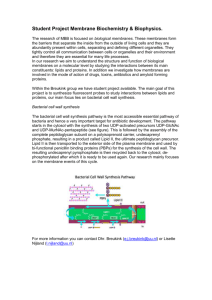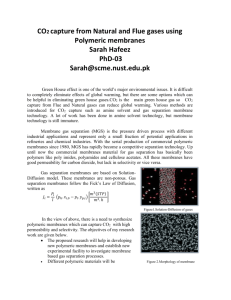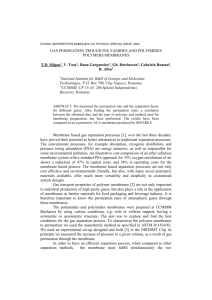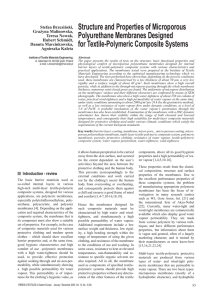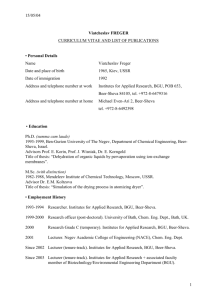Polymer based Ionic liquid gel membranes for gas and vapour
advertisement
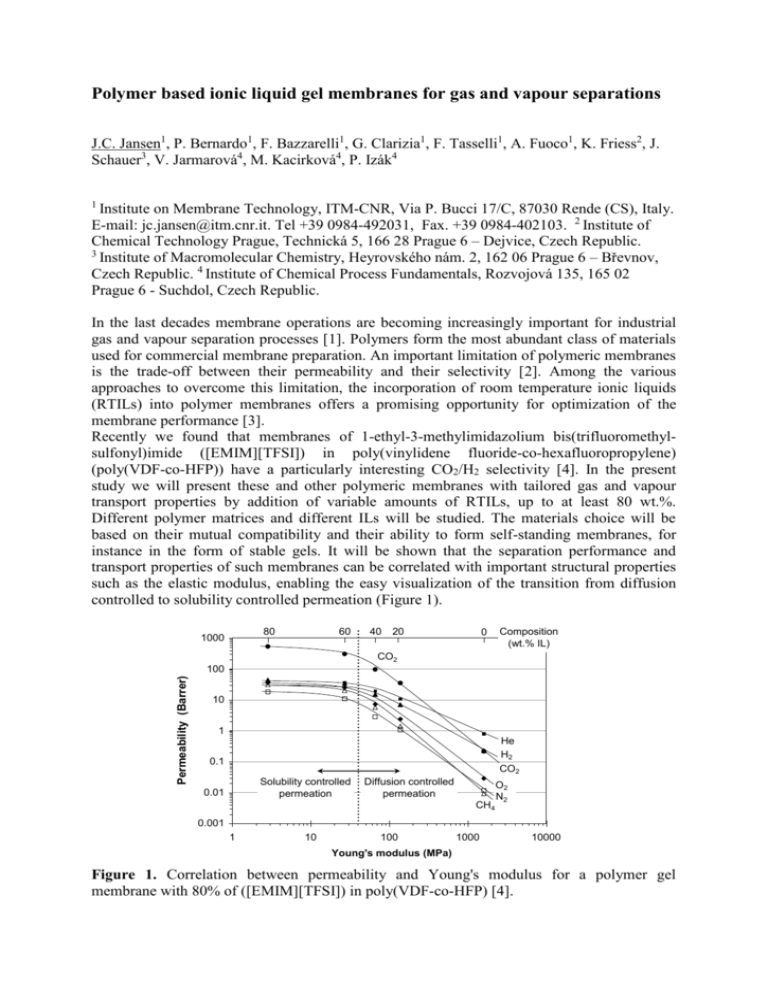
Polymer based ionic liquid gel membranes for gas and vapour separations J.C. Jansen1, P. Bernardo1, F. Bazzarelli1, G. Clarizia1, F. Tasselli1, A. Fuoco1, K. Friess2, J. Schauer3, V. Jarmarová4, M. Kacirková4, P. Izák4 1 Institute on Membrane Technology, ITM-CNR, Via P. Bucci 17/C, 87030 Rende (CS), Italy. E-mail: jc.jansen@itm.cnr.it. Tel +39 0984-492031, Fax. +39 0984-402103. 2 Institute of Chemical Technology Prague, Technická 5, 166 28 Prague 6 – Dejvice, Czech Republic. 3 Institute of Macromolecular Chemistry, Heyrovského nám. 2, 162 06 Prague 6 – Břevnov, Czech Republic. 4 Institute of Chemical Process Fundamentals, Rozvojová 135, 165 02 Prague 6 - Suchdol, Czech Republic. In the last decades membrane operations are becoming increasingly important for industrial gas and vapour separation processes [1]. Polymers form the most abundant class of materials used for commercial membrane preparation. An important limitation of polymeric membranes is the trade-off between their permeability and their selectivity [2]. Among the various approaches to overcome this limitation, the incorporation of room temperature ionic liquids (RTILs) into polymer membranes offers a promising opportunity for optimization of the membrane performance [3]. Recently we found that membranes of 1-ethyl-3-methylimidazolium bis(trifluoromethylsulfonyl)imide ([EMIM][TFSI]) in poly(vinylidene fluoride-co-hexafluoropropylene) (poly(VDF-co-HFP)) have a particularly interesting CO2/H2 selectivity [4]. In the present study we will present these and other polymeric membranes with tailored gas and vapour transport properties by addition of variable amounts of RTILs, up to at least 80 wt.%. Different polymer matrices and different ILs will be studied. The materials choice will be based on their mutual compatibility and their ability to form self-standing membranes, for instance in the form of stable gels. It will be shown that the separation performance and transport properties of such membranes can be correlated with important structural properties such as the elastic modulus, enabling the easy visualization of the transition from diffusion controlled to solubility controlled permeation (Figure 1). 80 1000 60 40 20 0 Composition (wt.% IL) CO2 Permeability (Barrer) 100 10 1 He H2 CO2 0.1 Solubility controlled permeation 0.01 Diffusion controlled permeation CH4 O2 N2 0.001 1 10 100 1000 10000 Young's modulus (MPa) Figure 1. Correlation between permeability and Young's modulus for a polymer gel membrane with 80% of ([EMIM][TFSI]) in poly(VDF-co-HFP) [4]. The membrane properties will be studied by single gas permeation measurements to determine the basic transport parameters (permeability, solubility and diffusivity), and by mixed gas and gas/vapour permeation measurements to determine their actual separation performance under representative conditions. In addition to self-supported dense membranes, also supported thin film composite membranes will be evaluated. Their performance will be discussed in view of important industrial applications. Acknowledgements: Funding was received from the European Community's Seventh Framework Programme (FP7/2007-2013) under grant agreement no. NMP3-SL-2009-228631, project DoubleNanoMem, from the Czech Science Foundation (Grant No. P106/10/1194) and from the CNR-CAS bilateral agreement 2010-2012. References 1. P. Bernardo, E. Drioli, G. Golemme, Membrane gas separation. A review / State of the art, Ind. Eng. Chem. Res. 2009, 48, 4638. 2. L. M. Robeson, The upper bound revisited, J. Membr. Sci., 2008, 320, 390. 3. P. Scovazzo, Determination of the upper limits, benchmarks and critical properties for gas separations using stabilized room temperature ionic liquid membranes (SILMs) for the purpose of guiding future research, J. Membr. Sci. 2009, 343, 199. 4. J.C. Jansen, K. Friess, G. Clarizia, J. Schauer, P. Izák, High ionic liquid content polymeric gel membranes: preparation and performance. Macromolecules 2011, 44, 39-45. 5. K. Friess, J.C. Jansen, F. Bazzarelli, P. Izák, V. Jarmarová, M. Kačírková, J. Schauer, G. Clarizia, P. Bernardo, High ionic liquid content polymeric gel membranes: correlation of membrane structure with gas and vapour transport properties, Submitted.




